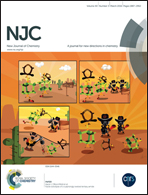Aggregate-based sub-CMC solubilization of n-alkanes by monorhamnolipid biosurfactant
Abstract
Solubilization of n-decane, dodecane, tetradecane and hexadecane by monorhamnolipid biosurfactant (monoRL) at concentrations near the critical micelle concentration (CMC) was investigated. The apparent solubility of all four alkanes increases linearly with increasing monoRL concentration either below or above the CMC. The capacity of solubilization presented by the molar solubilization ratio (MSR), however, is stronger at monoRL concentrations below the CMC. The MSR decreases following the order dodecane > decane > tetradecane > hexadecane at monoRL concentrations below the CMC. Formation of aggregates at sub-CMC monoRL concentrations was demonstrated by dynamic light scattering (DLS) and cryo-transmission electron microscopy. DLS-based size (d) and zeta potential of the aggregates decrease with increasing monoRL concentration. The surface excess (Γ) of monoRL calculated based on alkane solubility and aggregate size data increases rapidly with increasing bulk monoRL concentration and then asymptotically approaches the maximum surface excess (Γmax). The relationship between Γ and d indicates that the excess of monoRL molecules at the aggregate surface greatly impacts the surface curvature. The results demonstrate formation of aggregates for alkane solubilization at monoRL concentrations below the CMC, indicating the potential of employing low concentrations of rhamnolipid for enhanced solubilization of hydrophobic organic compounds.



 Please wait while we load your content...
Please wait while we load your content...